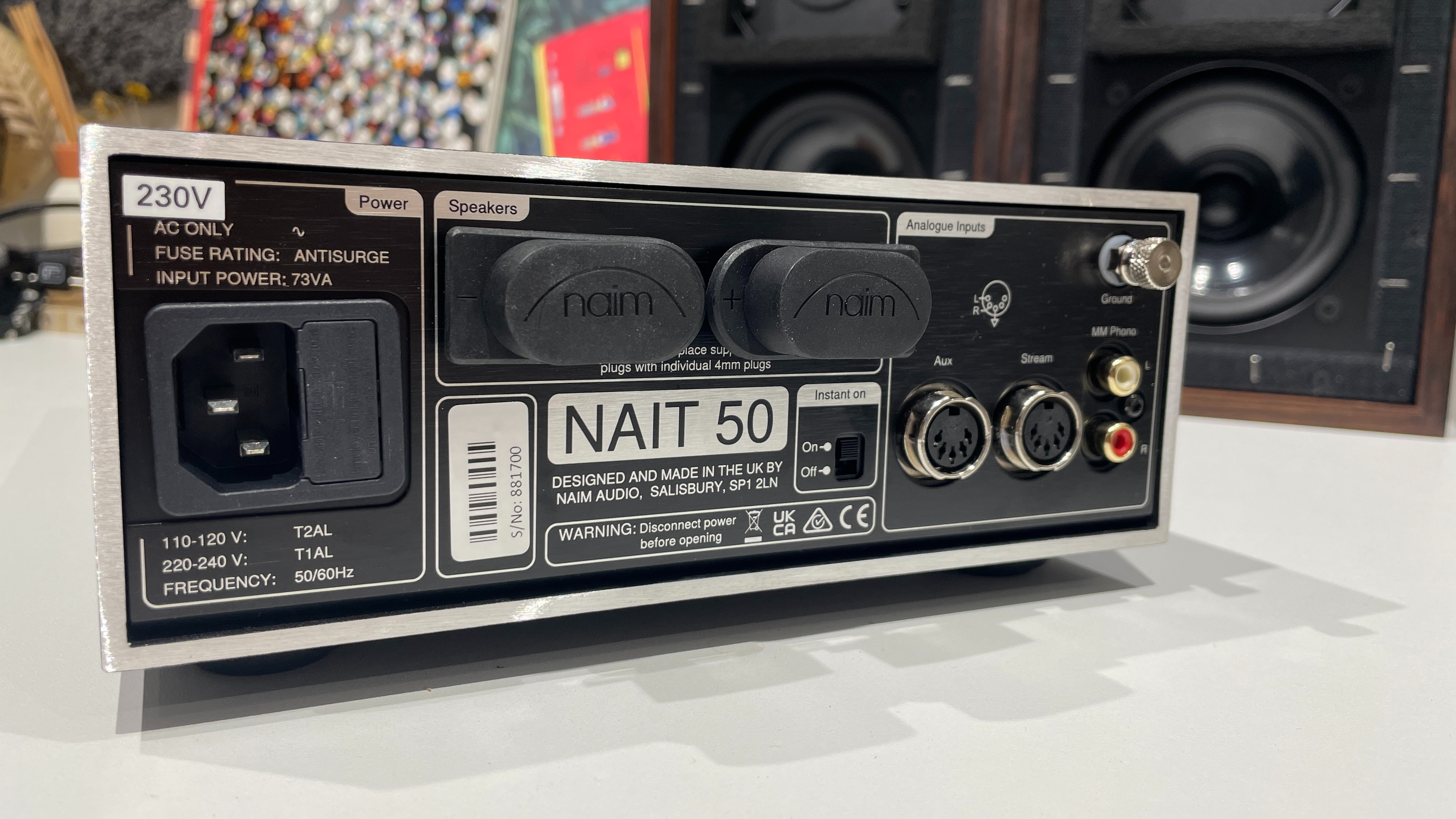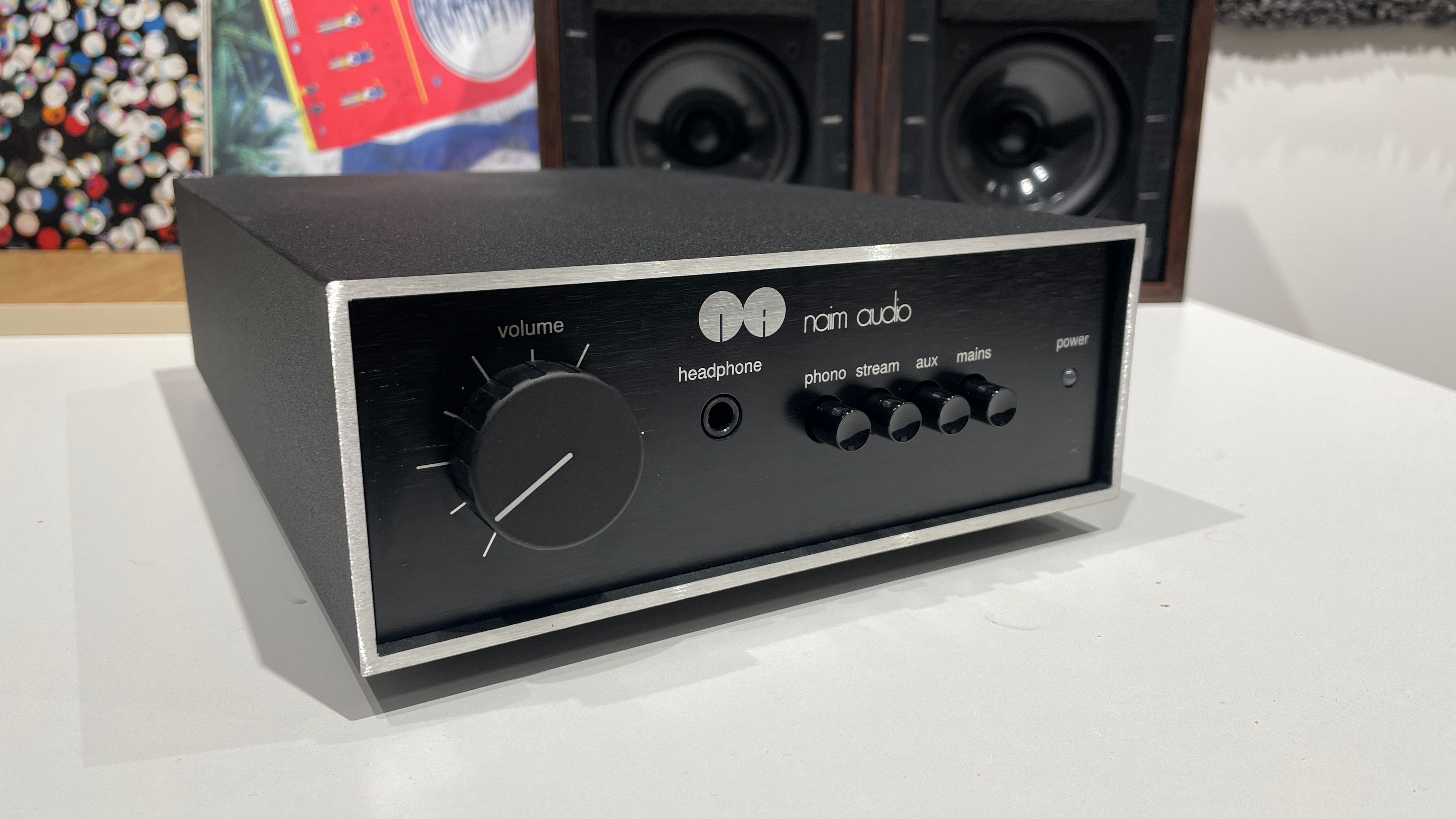Why you can trust What Hi-Fi?
Naim is just one of the handful of venerated audio brands celebrating its 50th anniversary in 2023. Along with Rega, QED and Linn, Naim Audio has been a fixture in the British hi-fi landscape ever since Julian Vereker founded the company in 1973.
Of the many amplifiers that Naim has manufactured since, the original Naim NAIT (retroactively called the Nait 1) holds a special place in hi-fi history. The Naim Nait integrated amplifier didn’t come about until 1983, and despite its now iconic status, it was a bit of an oddity when it launched. Along with a low power rating that befuddled many, it was Naim’s first-ever integrated stereo amplifier (combining power and preamp into one unit), which was a departure from its usual separates approach.
The Naim Nait 50 we have here is a limited edition product, paying homage to 1983’s original Nait 1 and released in conjunction with Naim’s 50th anniversary. How limited? Only 1973 units are being made (in honour of Naim’s founding year) and the amp is yours for a cool £2699. If only it had been priced at £1973 as well – the symmetry would have been neat.
Price






That price tag might raise your eyebrows (it did ours, both of them) as the original Nait 1 cost between £179 and £199 in 1984, according to our What Hi-Fi? archives. In today’s money, that would be equivalent to roughly £600 – a price point occupied by today’s Arcam A5 and Cambridge Audio CXA61 amplifiers.
The original Nait was one of the six contenders for the ‘Best amplifier under £250’ gong in the 1985 What Hi-Fi? Awards (Nov 1984 issue, which cost just 95p), and we noted that: “The Naim NAIT is a little upmarket from the NAD and Creek. Used in conjunction with a rather famous turntable, the NAIT has deserved its reputation as a smooth, powerful and expensive amplifier. Selling for £199 it’s a truly good-quality, sub-£200 model.”
That £2699 price tag is indicative of the Nait 50 amp’s special, limited edition status (it isn’t alone in pricing up limited edition models, and there are genuine reasons to justify that additional outlay), but if we were to give this Naim amp the full What Hi-Fi? review treatment, it would be going head-to-head against its Nait XS 3 (£2499) sibling, a current and excellent Award-winning integrated that can also draw its lineage straight through from the original Nait. We don’t give a star-rated review to limited edition products, however, with the Nait 50 instead getting a more extensive hands-on treatment and deep dive here as we explore its history and give it a thorough listen.
Unlike Musical Fidelity, who delivered a mostly faithful reimagining of its iconic A1 Class A amplifier this year (and made it available as a full production model), Naim has gone in a different direction. The Nait 50 may be a limited edition model, but it’s infused with more new engineering than you’d think at first glance. It’s actually a modern amplifier designed as a tribute to the original; it mirrors the original's appearance and replicates its sonic flavour, but there is an entirely new amplifier design inside.
The latest hi-fi, home cinema and tech news, reviews, buying advice and deals, direct to your inbox.
Yes, £2699 is quite a lot to pay even for a limited edition amplifier, and there are strong rivals today that can compete with it on a sound-per-pound value. But that’s not the point of this Nait 50. It’s a chance to own an homage to Naim’s history, and that kind of sentimentality has its own charm and is, for many, priceless…
Design & build quality

We know the retro-modern design trend is popular at the moment, but there is something utterly charming and timeless about the Nait 50.
Yes, it looks exactly like the old Nait 1. It features the same compact “shoebox” chassis with a chrome bumper design as the original. The half-width design is rare to see in mainstream hi-fi, but it is favourably viewed by many members of the What Hi-Fi? review team. Cyrus Audio and Rega have form in manufacturing half-width amps, for instance, while brands like Cambridge Audio and Eversolo are increasingly making new products with a small footprint (but no less mighty performance).
Even if you’re a fan of the ‘olive’ Naim amplifiers, prefer a full-width design or would rather have something more shiny and sleek, we think you’ll still find there is just something so appealing about the Nait 50. We had it living on our listening room’s racks for a good few weeks and it looked absolutely at home with products both old and new. It is a lovely little thing. The build quality is solid: it’s well made and finished, and Naim has stayed faithful to the aesthetics, even down to the non-centred old Naim logo on the front panel.
There are plenty of products that look “of their time” and fall out of fashion once they enter the next decade, but for the sheer simplicity of this design, the Nait 50 looks – there’s no other way to put it – cool. It isn’t just nostalgia speaking, either.

In our sister title New Hi-Fi Sound’s June 1984 review, they grumbled about the original Nait’s “rather poorly fitting front fascia” – you’ll be pleased to know that the front and rear panels of this Nait 50 model are now made of high-quality anodised aluminium and there’s no issue with the fit and finish. The balance control spindle of the original has been replaced by a 6.3mm headphone socket (more on this later), and the row of buttons to select the three inputs are now labelled accordingly: phono, stream and aux (updated from phono, tuner and tape). The once-grey volume dial (still rather unusually situated on the left-hand side) is now machined from solid aluminium and is finished in black to match the rest of the amp.
It’s even simpler around the back: a pair of phono inputs with ground, two analogue DIN-connector inputs, and one pair of speaker terminals. And that’s it.
The Nait’s simplicity was praised in the September 1984 issue of What Hi-Fi?: “The Naim Nait epitomises the ‘straight-through’ approach… a British speciality where there is an absolute minimum of switches and extra circuitry in the way of the signal, and facilities are few as a result. All the emphasis is on sound quality.”

It’s not all rose-tinted...
We do have some quibbles with the Nait 50 while using it, however. To start with, there’s no remote control. Even the new Musical Fidelity A1 threw us modern hi-fi listeners a bone by adding a small remote control when the original one didn’t. We like using the Naim unit’s volume dial, but found it’s harder to make subtle changes in volume than it should be. It goes from quiet to loud too quickly; we’d have liked more travel in between to allow us to fine-tune the volume level we want.
Secondly, the mains button is identical to the input buttons and, rather confusingly, the corresponding power status LED emits light (albeit less strongly) even in standby mode. It’s not always obvious to see at a glance if the amp is turned on or not by that semi-glowing LED, so if you’re not hearing music playing when you’ve plugged in your sources and speakers, just press the mains button to see if it’s actually fully powered on. If the LED glows brighter, that means it’s now on and music will flow. The Nait 50 has an auto standby mode by default, which activates at exactly 19 minutes – you can deactivate this by ensuring the “Instant On” switch at the back is on.
And finally, Naim uses DIN connectors for the line-level analogue inputs; there are no standard RCA connectors to be seen. So if you have a source that uses connections other than DIN and you don’t already have the right cable, then you’ll have to buy one for yourself. Does Naim include a DIN cable in the box with the Nait 50? It does not, which feels rather mean for a limited edition product and the relatively high asking price. However, you can easily buy the right DIN-to-RCA (or your connection of choice) cable from Naim and various other cable manufacturers. We used both a Naim-supplied cable as well as a higher-end Vertere Acoustics Redline DIN-to-RCA cable during our listening period.

Internally, an entirely modern amplifier design
Naim could easily have left it at that, but the brand has actually given a full overhaul of the amplifier’s insides.
Let’s talk power first. The original Nait 1 was met with derision at first launch because of its low power rating. Early reports weren’t firm about the exact power rating (some claiming as low 'about 8 watts') but we can confirm that the original was rated at 15W per channel into 8 ohms (thanks to Jason Gould of Naim for confirming this at the High-End Munich Show 2023).
In the new Nait 50, that’s gone up to 25W per channel into 8 ohms. That’s a decent step up, but even if it still won’t shake your floorboards, don’t be deceived into thinking that means the Nait 50 is some feeble performer. More power isn’t always the solution, we find. Some of our favourite amplifiers quote a low power rating, from the current Rega io (rated at 30W into 8 ohms) to the Pathos InpolRemix (a Class A design rated at just 10W!)
The Nait 50’s moving magnet phono stage is “all new”, says Naim, while the power amplifier design is based on the latest incarnation of the excellent NAP 250 (another 2023 launch, now in its sixth generation). The headphone amplifier section is entirely new, too – there wasn’t one in the original Nait at all – and this circuit has borrowed from another 2023 launch, the five-star NSC 222 streaming preamp. We tip our hats to Naim for offering a way to plug in our trusty wired headphones to listen to music more privately, especially as headphones have increasingly become a more common way of listening, and not just in the middle of the night. Additionally, the input switching is now done electrically, rather than mechanically, which results in shorter signal paths.


In practice, the Class A/B design of the Naim Nait amp (both the original and this limited edition 2023 version) has more than ample grunt to drive a wide variety of speakers. Back in the Jan 1984 issue of New Hi-Fi Sound (pictured above), in answer to a reader’s query that “...the low power rating of the Nait leads me to consider speakers of a medium or high efficiency”, the magazine replied: “First and foremost, the Naim Nait, in spite of its seemingly poor theoretical performance, is capable of driving far more difficult speaker loads than amplifiers with much higher outputs. Consequently, do not feel that the Nait is a limiting factor in your choice of loudspeakers.” We happily echo that statement here. Sure, the Nait 50 may struggle to drive grossly inefficient speakers or deliver concert hall scales of sound, but for your average-sized listening room with typical speakers, the Nait 50 is more than capable.
During our time with the Nait 50, we plugged the amp into a variety of speakers we had at hand in our listening rooms. From our reference ATC SCM50 and Epos ES14N speakers to the more modest Bowers & Wilkins 607 S3 and 606 S3 standmounts, along with the PMC Prodigy 5 towers to the similarly retro Musical Fidelity LS3/5A speakers – we found that the power or sensitivity handling wasn’t an issue at all when finding the right speaker pair to suit the Nait 50’s talents. It’s far more about compatibility; about matching the sonic signatures between products to get the best results.
Sound quality

So how does this limited edition Nait 50 amp actually sound? Incredibly fun. While it has been redesigned to modern standards, Naim’s engineers have done a great job of ensuring that this Nait 50 retains the enthusiastic sonic character of the original Nait 1 that was so liked. During listening, our technical editor Ketan Bharadia kept referring it to as having a “puppy dog-like” character – it’s zippy, energetic and inherently likeable.
There’s ample detail and clarity, with bags of punch. The amount of energy and drive that keeps a song’s momentum going – whether it’s Eminem’s The Way I Am, Alt-J’s Breezeblocks, Circling by Four Tet or Whatta Man by Salt-N-Pepa/En Vogue – is what stands out most with the Nait 50.
Regardless of genre, songs are handled with terrific agility and dynamic expression, with an innate understanding of the rhythmic interplay between instruments to make it musically enjoyable. There’s a good amount of weight and power to the proceedings too, keeping us satisfied as the brooding basslines in Massive Attack’s Angel and Paradise Circus hit with impact.
In New Hi-Fi Sound’s June 1984 review (you can read the full review, pictured below), David Präkel states that “the NAIT has an immediately distinctive sound” which is “coloured” – the same can be said about the Nait 50 and as a result, you are always aware of the amp itself. But Prakel also says, “the NAIT is an exceptional communicator of the ‘message’ of music, namely the pitch, shapes and independence of the notes.” We agree. Despite the Nait 50’s obvious flavour, it doesn’t take away from how precise the edges of notes are, how cleanly the vocals come through or how there’s a richness to the instruments when listening to Agnes Obel’s beautiful Aventine album.
We used various sources during our time listening to the amp, including our reference Naim ND555/555 PS DR music streamer, a Cyrus CDi CD player and our reference Technics SL-1000R turntable. The amp’s general character is consistent across all inputs. When listening through the analogue DIN inputs (connected to the Naim streamer), the amp’s energetic character is applied to every song. While this means it doesn’t make a meal out of any poor recordings, it is clear that the Nait 50 isn’t quite as transparent when relaying the differences in recording qualities as the best of the competition at this price.
Moving on to playing albums on the Technics turntable, and the Nait 50 remains an enthusiastic performer, but still manages to convey the lo-fi and intimate feel of Elliott Smith’s Either/Or.
The headphone amplifier, on the other hand, is decent but not the Nait 50’s strongest point. We listened with the Grado SR325x open-backs plugged in, and there’s a pleasing immediacy to the delivery. But it’s not quite as clear or detailed compared with the other inputs.
Other amplifiers at this level today – such as Rega’s Elicit Mk5 and Naim’s own Nait XS 3 – are able to deliver a larger-scale performance with more detail and lower-end heft. But the Nait 50 is such a likeable performer that we can’t stop grinning when we listen to it.

Nait 50 vs Nait XS 3: sibling rivalry
The comparison with the current Nait XS 3 proves to be fascinating, as it’s a completely different proposition and sonic character. To our surprise, it’s not quite as punchy, clean, precise or as lively as the limited edition Nait 50. Bass performance isn’t as impactful, with the very same Massive Attack basslines sounding a touch hazy. But the Nait XS 3 is subtler, with more layers of texture unearthed around instruments and voices.
It’s a more relaxed and transparent performer compared to the Nait 50’s endless enthusiasm. The Nait XS 3 is more attuned to the differences in recording qualities and era, being able to communicate the feel and mood of a song more deftly and with more nuance. One thing we always look out for when testing hi-fi kit is “Does this sad song make us feel sad?”, and the regular XS 3 amp fits this brief better. Nick Cave sounds appropriately bittersweet and contemplative in Into My Arms.
The Nait 50 certainly offers more punch and crisper edges, and the sense of lively, fun attack is infectious – if not always necessarily authentic. It’s not a laidback performer at all, and we even find the phono stage performance sounds better here than on the XS 3. But the Nait XS 3 does offer a more mature balance that many will prefer.

Compatibility: matching products is key
Whichever balance you prefer, what’s of most importance is what you pair the amplifier with. In the Nait 50’s case, as it’s capable of dealing with a wide range of sources, it’s the speaker combination that proves to be the trickier match. The key takeaway is to avoid pairing the amp with any speakers that sound too bright or lively, as you’ll need something to counterbalance the Nait 50’s energy without losing any of that infectiously likeable charm.
The new B&W 607 S3 (£599), for instance, is too excitable – combined with the Nait 50, the top end is too aggressive to our ears and the overall effect doesn’t let you relax. The bigger, spacious-sounding B&W 606 S3 (£749) is a nicer combination thanks to its more deliberate, slightly more relaxed presentation. The Nait 50 in turn adds a bit of zest to the 606 S3’s mature sound, and you end up with a performance that’s open, composed, solid and detailed.
Go up the chain to something more price-appropriate, and we have the equally special Musical Fidelity LS3/5A speakers (£2349), which are designed to BBC RD1976/29 specifications. Visually, the two retro products look absolutely fabulous together. Sonically, it’s not quite as good a match as it is aesthetically – the Musical Fidelity’s smaller-scaled sound and lack of bass authority don’t quite gel with the Nait 50’s punchy nature. But they flow and glide through music in a lovely way when it comes to voices and piano (anything in the midrange, essentially). These speakers don’t have the required punch and timing talents to match the demands of the Nait 50 amp, though. Our reference Epos ES14N speakers (£3750) deliver a more measured performance but are a little too out of the Nait’s league.
Verdict

Overall, while not perfect, this is a hugely entertaining and musical amp to listen to. It’s an obviously flavoured sound, but that’s the point of this amplifier: to capture the spirit of the original, iconic Nait 1 integrated amplifier.
Even months after our time with the Nait 50, we still can’t forget just how fun this amp was to listen to. Would we pick it over the Nait XS 3? We’re in two minds; if we could have both powering two different systems, we’d be very happy indeed.
MORE:
9 of the best Naim Audio products of all time
Read the full Naim Nait XS 3 review
I've heard over 150 products this year, and these are my 5 hi-fi highlights

Kashfia is the Hi-Fi and Audio Editor of What Hi-Fi? and first joined the brand 13 years ago. During her time in the consumer tech industry, she has reviewed hundreds of products (including speakers, amplifiers, turntables and headphones), been to countless trade shows across the world and fallen in love with hi-fi kit much bigger than her. In her spare time, Kash can be found tending to an ever-growing houseplant collection and shooing her cat Jolene away from spinning records.
- Ketan BharadiaTechnical Editor
What is a hands on review?
'Hands on reviews' are a journalist's first impressions of a piece of kit based on spending some time with it. It may be just a few moments, or a few hours. The important thing is we have been able to play with it ourselves and can give you some sense of what it's like to use, even if it's only an embryonic view.


